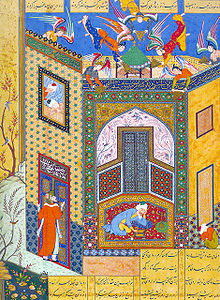Jami

Nur ad-Din Abd ar-Rahman Jami (Persian: نورالدین عبدالرحمن جامی) (August 18, 1414–November 19, 1492) was one of the greatest Persian poets in the 15th century and one of the last great Sufi poets.
Teachings
In his role as Sufi shaykh, Jami expounded a number of teachings regarding following the Sufi path. In his view, love was the fundamental stepping stone for starting on the spiritual journey. To a student who claimed never to have loved, he said, "Go and love first, then come to me and I will show you the way."[1]
Works

Another illustration from the Haft Awrang
Jami wrote approximately eighty-seven books and letters, some of which have been translated into English. His works range from prose to poetry, and from the mundane to the religious. He has also written works of history. His poetry has been inspired by the ghazals of Hafez, and his Haft Awrang is, by his own admission, influenced by the works of Nezami.
Divan of Jami
Among his works are:
- Baharistan (Abode of Spring) Modeled upon the Gulistan of Saadi
- Nafahat al-Uns (Breaths of Fellowship) Biographies of the Sufi saints
- Haft Awrang (Seven Thrones) His major poetical work. The fifth of the seven stories is his acclaimed "Yusuf and Zulaykha" which tells the story of Joseph and Potiphar's wife based on the Quran.
- Lawa'ih A treatise on Sufism
- Diwanha-i Sehganeh (Triplet Divans)
- Tajnīs ’al-luġāt (Homonymy/Punning of Languages) A lexicographical work containing homonymous Persian and Arabic lemmata.[2]
See also
Notes
- ^ http://wahiduddin.net/mv2/X/X_3_4.htm
- ^ Shīrānī, 6.
References
- E.G. Browne. Literary History of Persia. (Four volumes, 2,256 pages, and twenty-five years in the writing). 1998. ISBN 0-7007-0406-X
- Jan Rypka, History of Iranian Literature. Reidel Publishing Company. 1968 OCLC 460598 ISBN 90-277-0143-1
- Ḥāfiż Mahmūd Shīrānī. “Dībācha-ye awwal [First Preface].” In Ḥifż ul-Lisān [a.k.a. Ḳhāliq Bārī], edited by Ḥāfiż Mahmūd Shīrānī. Delhi: Anjumman-e Taraqqi-e Urdū, 1944.
External links
- Jami on PoetryPortal
- Jami on Iran Chamber Society Website
- Jami's Yusuf and Zulaikha: A Study in the Method of Appropriation of Sacred Text
- Jami's Salaman and Absal as Translated by Edward Fitzgerald. 1904
| Part of a series on Islam Sufism |
|---|
 |
|
|
